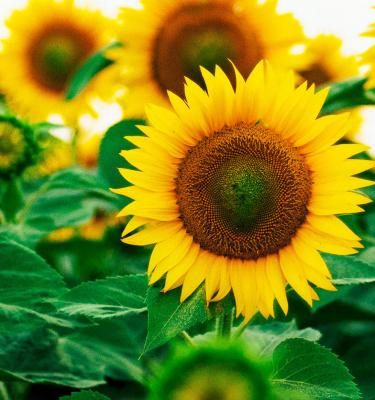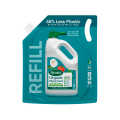

How to Grow Sunflowers
If you want to grow something spectacular, plant sunflowers. They come in a whole range of sizes from dwarf to giant and, as well as the classic golden-yellow flowers, you can also grow sunflowers with red, orange or even white blooms. Planting sunflowers (Helianthus annuus) is a great way to get kids into gardening, and they’re perfect for wildlife-friendly gardens.
The best sunflowers to plant
There are more than 70 different sunflower varieties available. Some dwarf varieties only grow 20 or 30cm high, while the tallest sunflowers can top 3m or more. Here are a few of our favourites:
Giant sunflowers
- Sunflower ‘Russian Giant’ – 3-4m (tall, with bright golden-yellow flowers up to 50cm across
Tall sunflowers
- Sunflower ‘Double Dazzler’ – to 2m tall, with multi-petalled deep yellow flowers
- Sunflower ‘Lemon Queen’ – to 2m tall, with pale lemon flowers
- Sunflower ‘Yellow Empress’ – to 2m tall, with large bright yellow flowers and black centres
Dwarf sunflowers
- Sunflower ‘Teddy Bear’ – 50cm (20in) tall, with round double yellow pompom flowers
- Sunflower ‘Dwarf Sensation’ – 20-30cm tall with bright yellow flowers, ideal for pots
Essential equipment list for growing sunflowers
To grow sunflowers at home in your garden, you will need:
- Sunflower seeds
- Rake
- Trowel
When to plant sunflowers in Australia
Sow sunflower seeds direct where the plants are to grow. In cooler areas, wait until the danger of frosts has passed, usually by late September.
- Clear the ground of weeds and dig in plenty of compost and soil improver or well weathered animal manure.
- Rake the ground to create a level surface with a fine, crumbly texture.
- Plant seeds 1.5cm deep, 10cm apart and water well.
- Once the seedlings have germinated, thin them out to 45cm apart.
Dwarf varieties may be direct sown into the garden in rows or groupings or into singly into 140mm pots of premium quality potting mix. Check the seed packet instructions for spacing in the garden.
Where to grow Sunflowers
Sunflowers have two essential needs – fertile soil and lots of sun. Once you’ve ticked those boxes, you can let your imagination run wild when planting sunflowers.
Plant dwarf sunflower varieties in containers and create your own ‘Van Gogh’-style effects. If you have the space, why not plant an avenue of sunflowers along a path? Or simply plant sunflowers in blocks in your borders for maximum impact in summer.
Growing sunflowers for picking
If you are growing sunflowers that will be picked to use in arrangements, you need bushy plants that will produce plenty of blooms. To encourage branching, pinch out the growing tips of the plants (the cluster of leaves at the top of the plant). The plants will respond by putting out lots of flower-bearing side shoots.
- For tall sunflowers, pinch out the tips when the plants reach 20cm tall.
- Cut back or pinch out dwarf sunflowers once they are 10-15cm tall, leaving just two pairs of leaves on the stem. When the plant has grown another 7-10 cm, repeat the process.
Caring for sunflowers
Run through the following steps to give your sunflowers the care and attention they deserve:
- Support tall sunflowers with stakes as they grow.
- Once the flowers appear, feed sunflowers weekly with an All Purpose liquid concentrate fertiliser diluted according to label directions.
- Water regularly during dry periods, especially the tall varieties, as it’s difficult for them to recover if they dry out and wilt.
- Watch out for slugs and snails which will devour young seedlings. Protect potted plants with copper tape or scatter snail and slug pellets.
- Once the flowers have finished, leave the heads to mature and dry on the plants for the birds – parrots, lorikeets, cockatoos and other wild birds love them! Alternatively, cut off the seed heads and store them in a cool, airy spot. They will keep for several months, and you can put one out occasionally for native birds when other food is scarce.
- In late autumn, pull up the plants and compost them.
How to harvest sunflower seeds for eating or later sowing
- To collect sunflower seeds, wait till the petals start to drop. You may need to cover the flowers with nets to protect them from birds.
- Cut the flowers off with a long stem.
- Cover the flowerheads with paper bags and hang the flowers somewhere warm and well-ventilated for a few weeks to dry.
- Once the sunflower seeds are dry, pull them off the heads by hand.
- Store sunflower seeds in an airtight container.
If you’ve never grown a sunflower, now’s the time to start. And with so many beautiful varieties available, the only difficulty about growing sunflowers is choosing which one to grow.
Fascinating facts about sunflowers
- The tallest sunflower on record was grown in Germany in 2014 and reached more than 9 metres in height.
- The central disc of a sunflower is made up of many individual tiny flowers. The petals around the edge of the sunflower are there to attract pollinators to the flowers in the centre.
- Sunflowers are heliotropic – this means they follow the sun, tracking its position so that the developing flowerbuds are always facing the sun. Fully-grown sunflowers don’t tend to follow the sun, as the flowerheads are too heavy.
- If sunflowers aren’t pollinated by insects in the normal way, they can pollinate themselves. Each tiny flower in the central disc is able to curl its female stigma around to pick up pollen grains from the the flower’s male anthers. The pollen sticks to the stigma and sends shoots down into the ovary where it fertilises the ovule which will then develop into a seed.
Common sunflower pests & diseases
| Sunflower leaves turning yellow |
Sunflower leaves turning yellow may be caused by sclerotinia disease, a soil- borne fungus. Affected plants turn yellow. wilt and die. The stems often rot near the base, and white fluffy fungal growth appears at the rotting area, followed by black seed-like structures.
|
| Slugs and snails |
Common sunflower pests include slugs and snails. which will attack young sunflower seedlings, and can be identified by the slime trails that they leave, as well as the damage they do. As the plants grow taller they are less at risk of damage.
|



